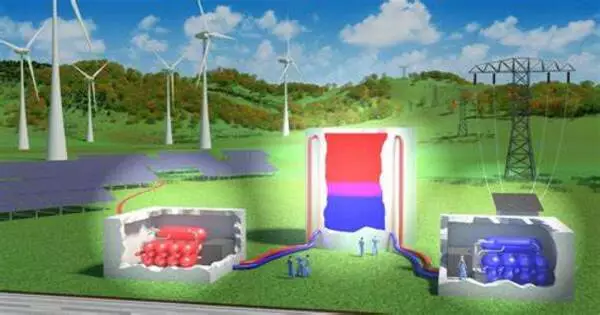A Carnot battery is a type of energy storage system that uses thermal energy storage to store electricity. During the charging process, electricity is converted to heat and stored. The stored heat is converted back into electricity during the discharging process.
The term “Carnot battery” comes from Carnot’s theorem, which describes the maximum efficiency of heat energy conversion into mechanical energy. The term “battery” indicates that this technology’s purpose is to store electricity. The Carnot efficiency limits the discharge efficiency of Carnot batteries.
The concept of this technology was patented by Marguerre 100 years ago, but its development has recently been revitalized due to the increased use of renewable energies and the need to increase the total recovered energy delivered from such sources. Andre Thess coined the term “Carnot battery” in this context in 2018, prior to the first International Workshop on Carnot Batteries.
The Carnot cycle is a theoretical thermodynamic cycle that describes the maximum efficiency that a heat engine can achieve when operating between two temperature reservoirs. It serves as a standard for the highest level of efficiency that any heat engine can achieve. The temperatures of the hot and cold reservoirs that a Carnot engine operates between determine its efficiency.
Depending on the technology used, energy storage systems can store energy in a variety of forms, including chemical, electrical, mechanical, and thermal. Batteries (chemical and electrical energy storage), flywheels (mechanical energy storage), and pumped hydro storage are common examples.
Application
Carnot batteries can be used as grid energy storage to store excess power generated by variable renewable energy sources and to generate electricity when required. Some Carnot battery systems can store heat or cold and use it for other purposes, such as district heating and cooling for data centers.
By replacing the coal-fueled boiler, these have been proposed as a solution for converting existing coal-fired power plants into fossil-fuel-free generation systems. Existing power plant facilities, such as power generation and transmission systems, can be used.
Advantages and disadvantages
The Carnot battery has also been known as “Pumped Thermal Electricity Storage” (PTES) or “Pumped Heat Electricity Storage” (PHES). This relatively new technology has quickly emerged as one of the most promising large-scale energy storage solutions.
The main advantages of the Carnot battery are:
- Free choice of site;
- Small environmental footprint;
- Life expectancies of 20–30 years;
- Optional low-cost backup capacity;
The components of a decommissioned fossil-fueled power plant can be partially reused to construct the Carnot batteries unit; the major disadvantage of this technology is: the limited roundtrip efficiency round, which relates the electricity Wdis delivered during discharge to the electricity Wchar required to charge the system. Carnot batteries typically aim for efficiencies of 40-70%, which is significantly lower than that of pumped-storage hydroelectricity (65-85%).
















